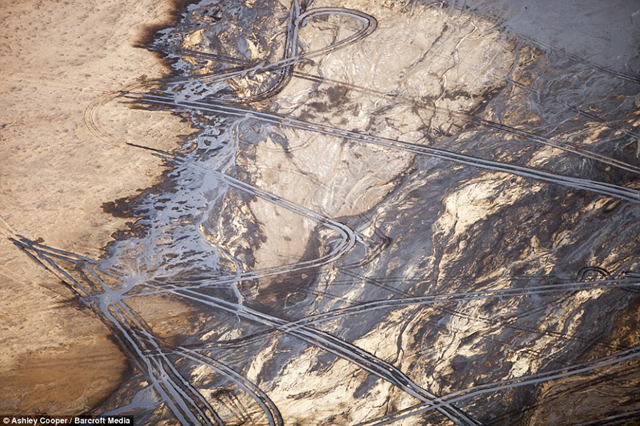Photo gallery: Aerial view of deforestation at the Tar Sands mine in Alberta, Canada
By Mark Duell
18 October 2012 These incredible pictures show the bleak landscape of bitumen, sand and clay created by the frantic pursuit of 173 billion barrels of untouched oil. The Tar Sands in Alberta, Canada, are the world’s third largest oil reserve – but lush green forests once blanketed an area there larger than England. The region where the blackened earth now stands has been dubbed as the most destructive industrial project on earth by shocked environmentalists. Millions of barrels of tar sands oil have been extracted from underground – producing five times as many greenhouse gas emissions as normal extraction. And the Boreal forest – once home to grizzly bears, moose, bison, deer and wolverines – is vanishing at a rate only second to Amazon deforestation.
Photographer Ashley Cooper said: ‘I knew a lot about the tar sands before I went there but nothing prepared me for the impact of actually seeing it. ‘The sheer scale of devastation is almost beyond comprehension. Oily, stained ground stretches for hundreds of miles where there used to be forest.
‘The constant stench of oil and chemicals is sickening. From the air, it’s even worse – you see endless miles of stacks of what look like matchsticks but are actually felled trees. ‘The forest is just gone, for as far as the eye can see. Dotted amongst the wasteland are the glistening, bizarrely beautiful tailing ponds, a toxic death-trap for wildlife.’ The tar sands cover 141,000 sq km of Alberta. Twenty per cent of this has 174billion recoverable barrels close enough to the surface to be strip-mined. This is done by removing the forest and the peaty soil beneath, before gas-heated water is then forced through the tar sand to melt and separate bitumen from the sand and clay.
It takes four barrels of water to retrieve one barrel of oil – creating large tailing ponds of dirty water that cover vast expanses.
Lawyer and environmentalist Polly Higgins said: ‘Runaway climate change becomes almost inevitable if the tar sands continue. ‘The tar sands should be classified as an act of ecocide and rendered illegal under international law. This is, in effect, a crime against humanity.’ […] Local doctors in Alberta are becoming concerned at the side effects of the industrial scale output on residents’ health. In a nearby settlement called Fort Chip, which has a population of 1,200 people, doctor John O’Connor has diagnosed six people with bile-duct cancer. The extremely rare disease normally affects only one in 100,000 people. […]


The problem is so simple.
These people are answering OUR demand for energy. Every one of us is an incredible energy consumption entity.
This will get worst until WE change our lifestyle.
It is that simple !
You want to save the world with one hand and you kill it with the other…
please, please wake up
this image explains well :
http://3.bp.blogspot.com/-N7xBx2_ZHss/UIAVia7XHDI/AAAAAAAAATg/-G1tMOR7hZI/s760/betrayal_by_aegis_strife-d5i2j40.jpg
claude